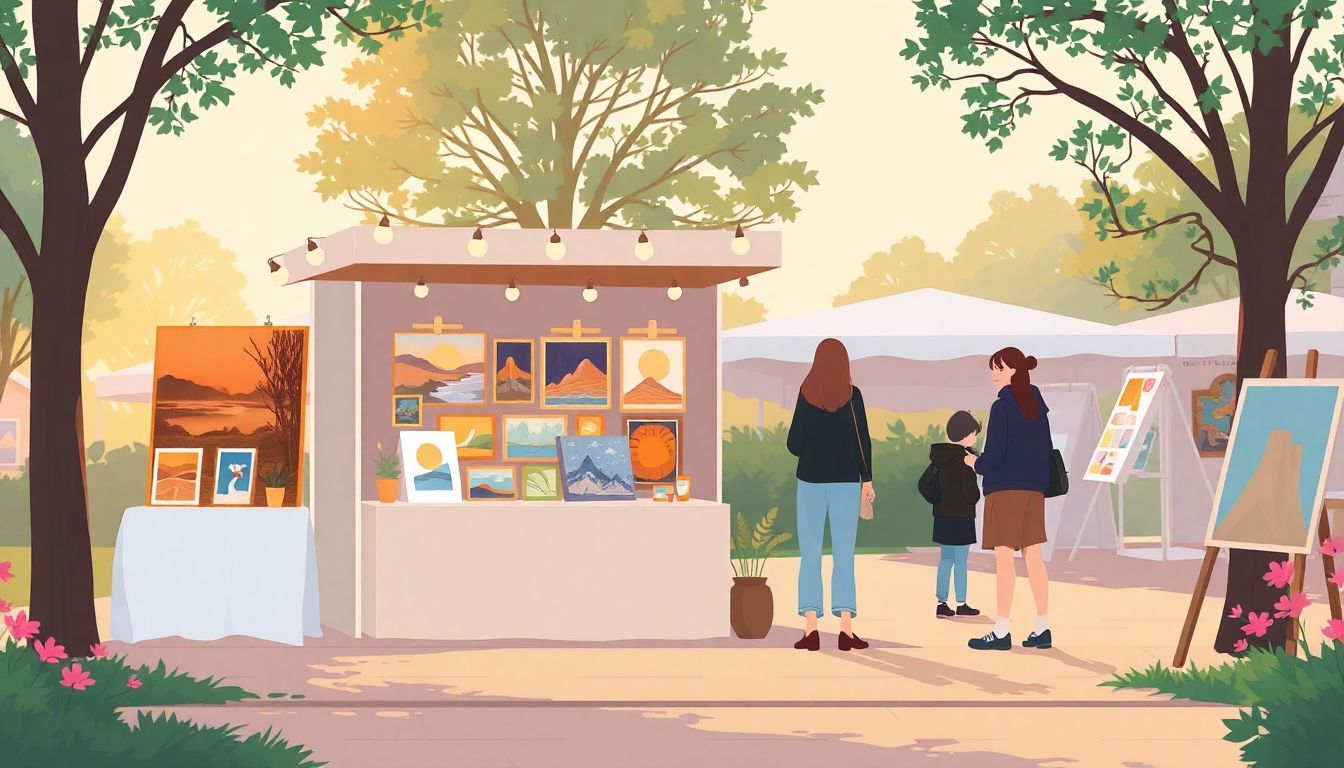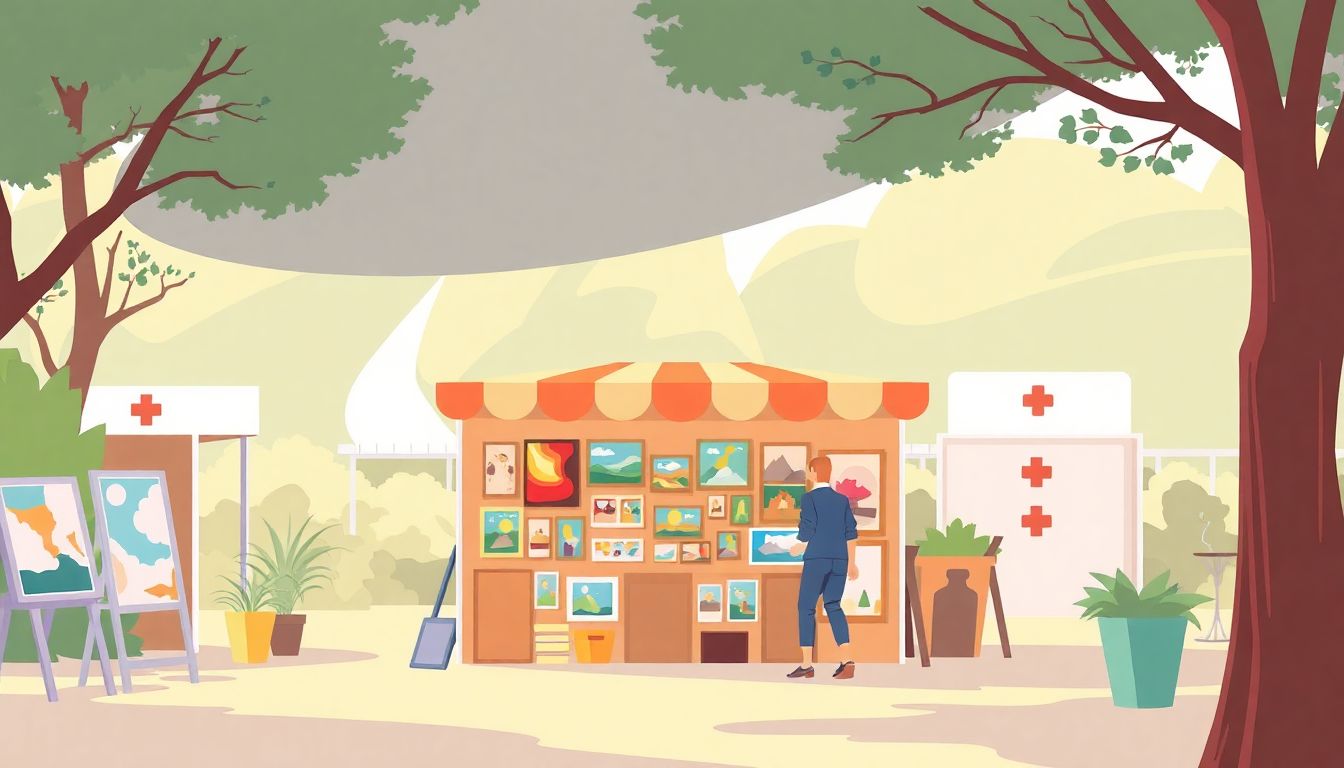Planning a community art fair can feel overwhelming, right? With so many details to juggle, it’s easy to get lost in the shuffle of organizing artists, vendors, and activities while trying to create a vibrant atmosphere. But don’t worry; you’re not alone in feeling this way!
Stick around, and I promise you’ll discover a treasure trove of prompts that can help you craft a successful art fair experience. These prompts will guide you in brainstorming themes, engaging local talent, and attracting visitors like bees to honey.
From figuring out how to market your fair to gathering feedback afterward, we’ll cover all the bases. Let’s unleash your creativity and turn your community art fair dreams into reality!
Key Takeaways
- Use specific prompts to streamline your community art fair planning for themes, marketing, and engagement.
- Establish a compelling theme to set the tone for the fair, focusing on local culture or sustainability.
- Engage local artists by inviting them personally and highlighting community benefits for their participation.
- Market your event effectively through social media, local ads, and community group outreach to maximize attendance.
- Include interactive workshops and activities for all ages to enhance attendee engagement.
- Collect feedback post-event to evaluate success and areas for improvement, ensuring future fairs are even better.
- Collaborate with local organizations for shared resources, enhancing the fair’s impact through partnerships.
- Implement a clear budget and explore fundraising options like sponsorships and grants for financial sustainability.

Best ChatGPT Prompts for Planning Community Art Fairs
Planning a community art fair can be both exciting and overwhelming.
Using specific ChatGPT prompts can help streamline the process and bring fresh ideas to the table.
Here are some prompts you can directly use:
- “List creative themes for a community art fair that celebrate local culture.”
- “Suggest a timeline for organizing a community art fair, including key activities and deadlines.”
- “Identify successful strategies for engaging local artists and getting their buy-in for participation.”
- “Create a checklist of essential items needed for planning a community art fair.”
Prompts for Creating Art Fair Concepts and Themes
Establishing a compelling theme for your art fair is crucial as it sets the tone for the entire event.
Here are some prompts to brainstorm innovative ideas:
- “Generate unique theme ideas for an art fair focusing on environmental sustainability.”
- “List 5 ways to incorporate local history into an art fair theme.”
- “Create an outline for an art fair centered around multicultural experiences and diversity.”
- “Suggest interactive concepts that enhance visitor engagement through storytelling in art.”
Prompts for Engaging Local Artists and Vendors
Engaging local artists and vendors is key to making your art fair a vibrant success.
Here are some prompts to help establish connections:
- “Draft an invitation message for local artists to participate in the upcoming art fair.”
- “List compelling reasons for local vendors to set up shop at the art fair, focusing on community benefits.”
- “Propose ideas for collaborative projects between artists and local businesses during the fair.”
- “Create a feedback survey for artists to evaluate their experiences at the art fair.”
Prompts for Marketing and Promoting the Art Fair
Effective marketing is essential for attracting attendees and participants.
Here are some prompts to aid in your promotional efforts:
- “Draft a social media campaign plan to promote a community art fair.”
- “Suggest local advertising ideas that could help raise awareness for the event.”
- “Create a press release template announcing the details of the art fair.”
- “List outreach techniques for engaging local community groups to spread the word about the art fair.”

Prompts for Organizing Workshops and Activities
Workshops and activities can bring an art fair to life by providing interactive experiences for attendees.
Here are some effective prompts to help you plan engaging sessions:
- “List five creative workshop ideas that cater to different age groups and skill levels at an art fair.”
- “Draft a schedule for a day of workshops, including time slots and facilitators for each session.”
- “Suggest materials and supplies needed for hands-on art workshops focused on community themes.”
- “Outline best practices for ensuring safety and effectiveness during art demonstrations.”
Prompts for Gathering Community Feedback Post-Fair
Getting feedback after the fair is crucial to understanding successes and areas for improvement.
Here’s how you can prompt ChatGPT to create insightful evaluation tools:
- “Create a post-event survey that captures attendee satisfaction and suggests areas for improvement.”
- “Draft questions for local artists and vendors to evaluate their experience and suggestions for future events.”
- “List methods for analyzing feedback data to enhance future community art fairs.”
- “Propose ways to publicly share the results of the feedback survey with the community to foster transparency.”
Prompts for Collaborating with Local Organizations
Collaboration can strengthen the impact of your art fair through shared resources and expertise.
Use these prompts to explore partnership opportunities:
- “Identify local organizations that align with art and culture and suggest ways to collaborate on the fair.”
- “Draft a partnership proposal for potential sponsors detailing benefits for them and the event.”
- “Create a list of cross-promotional activities that benefit both the art fair and local businesses.”
- “Suggest community initiatives that could be incorporated into the art fair to enhance local involvement.”
Prompts for Budgeting and Fundraising Ideas
Effective budgeting and fundraising are essential for a sustainable art fair.
Here are some actionable prompts to help manage finances:
- “Outline a detailed budgeting template for planning a community art fair including potential expenses.”
- “Suggest creative fundraising ideas that can be implemented before or during the art fair.”
- “Draft a sponsorship levels guide highlighting benefits for potential sponsors of the art fair.”
- “List potential grants and funding sources that support community art initiatives.”

Prompts for Safety and Accessibility Considerations
Safety and accessibility should be at the forefront when planning any community event, including art fairs.
Here are some prompts to make sure you cover all the necessary aspects:
- “List safety protocols for vendors to ensure a secure environment at the art fair.”
- “Suggest ways to make an art fair accessible for individuals with disabilities.”
- “Draft a plan for emergency procedures during the event, including first aid stations.”
- “Create a checklist for assessing venue safety for large gatherings, focusing on exits and crowd control.”
Conclusion
Planning a community art fair involves multiple layers of details, from engaging local artists to ensuring accessibility.
Using targeted ChatGPT prompts lets you streamline your efforts and discover innovative solutions for challenges you might face.
By tapping into these ideas and engaging your community, you’re setting the stage for a successful and memorable event.
FAQs
To engage local artists, host community meetings, utilize social media platforms for outreach, and offer incentives like booth discounts or promotion opportunities. Collaborating with local art schools can also introduce emerging talent.
To ensure accessibility, provide wheelchair ramps, clear signage, and adequate parking. Include sensory-friendly zones and consider bringing in services for those who may need assistance, such as interpreters or guides.
Utilize social media campaigns, collaborate with local influencers, and create engaging visuals. Host pre-fair events to generate excitement, and consider partnerships with local businesses to promote the fair across different channels.
Collect community feedback by distributing surveys via email or social media. Set up feedback stations at the event and encourage open discussions. Utilize online platforms to ensure diverse input from attendees and participants.
